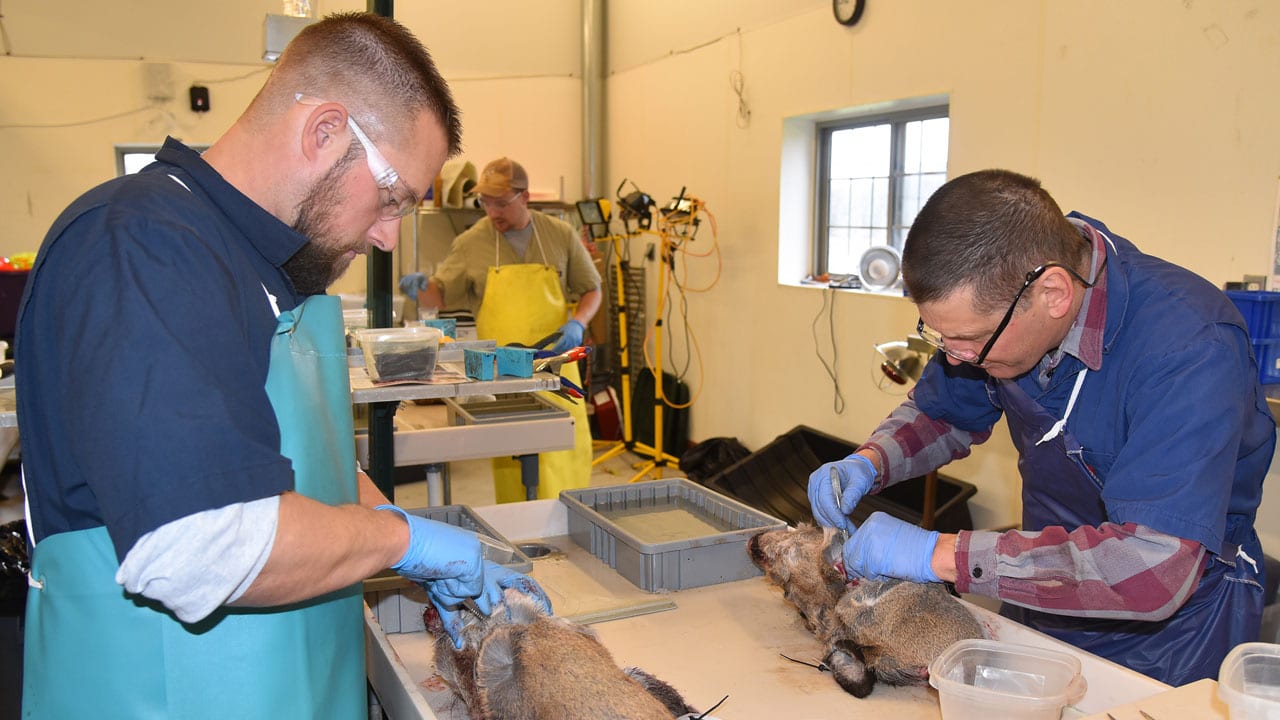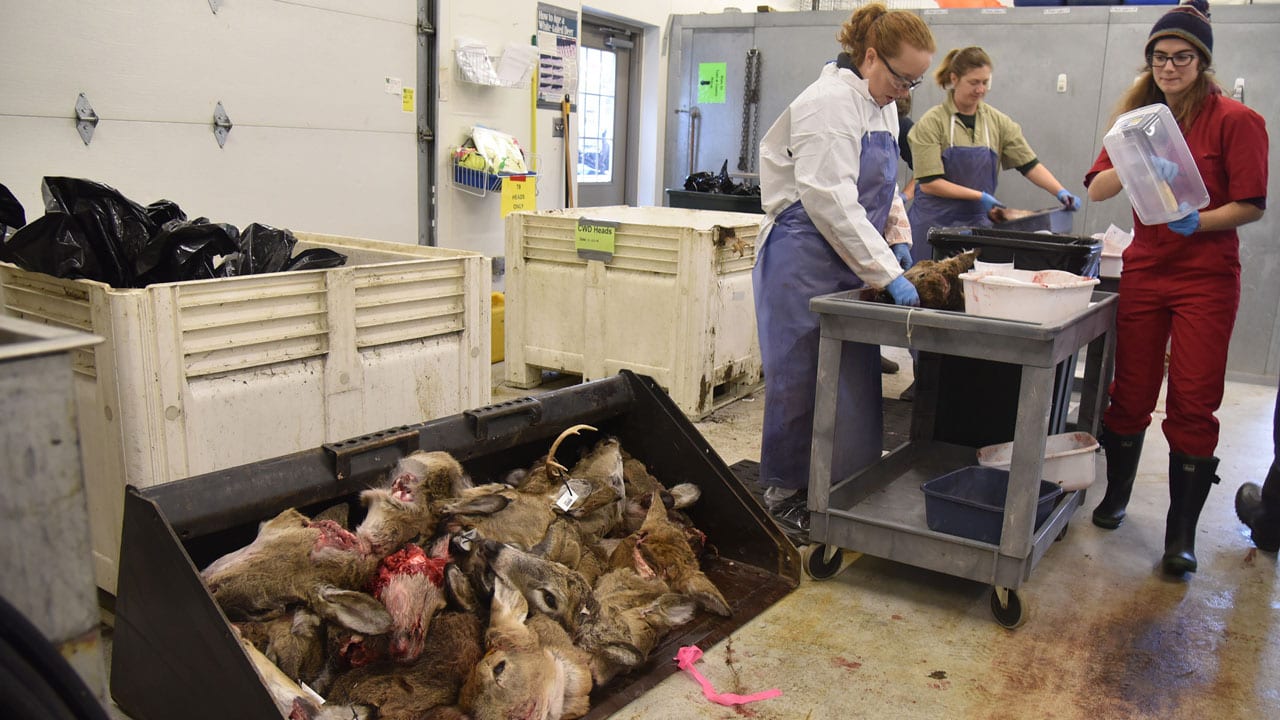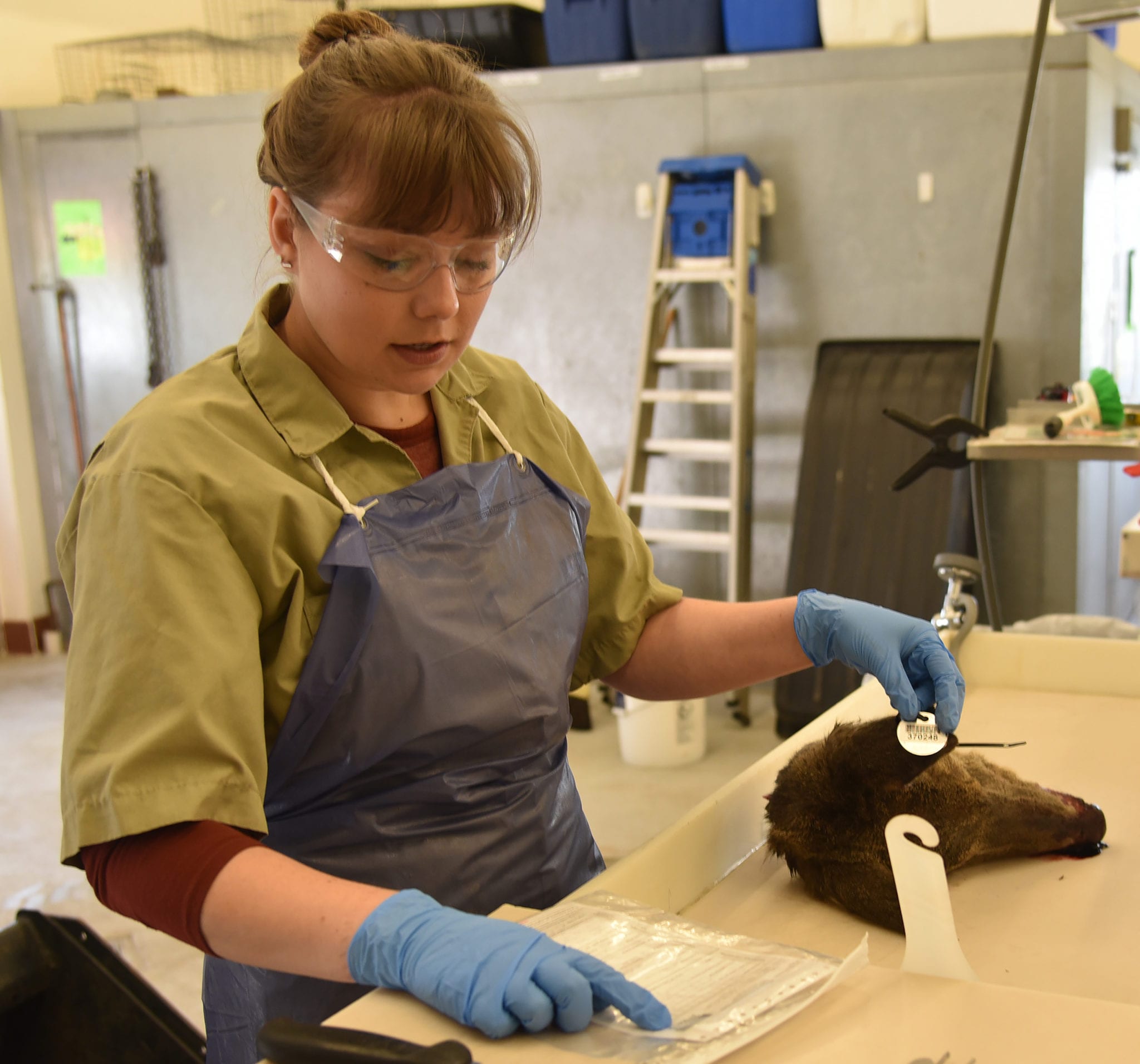Deer heads arrive in individual black plastic bags at the state’s main CWD processing station each fall, and depart in huge head-filled dumpsters a few days later after providing two tissue samples from their spine/brain intersection.
Those samples – a pair of lymph nodes – go into bar-coded plastic pouches that get sent to Madison to determine whether the deer had chronic wasting disease. This always-fatal disease has been documented in over 6,535 wild whitetails in Wisconsin since CWD’s discovery west of Madison in February 2002.

Wisconsin DNR wildlife biologists Josh Jackl, left, and Steve Hoffman remove lymph nodes from deer heads at the Black Earth CWD collection facility.
It’s hard to enter that Department of Natural Resources’ processing center during Wisconsin’s nine-day gun-deer season and not sense CWD’s enormity. Once arriving at the center, you struggle to look anywhere and not see freshly severed deer heads.
Heads already sampled are piled by the hundreds in a dumpster outside.
More recent arrivals – heads still shrouded in plastic – enter the sample-extraction line in large plastic crates holding about 100 heads each. A worker unbags the heads, and then two biologists take each head to a steel table, twist open the mouth with a jaw-spreader, examine the teeth in the lower jaw, and record the deer’s age based on tooth-wear patterns.
The heads then go into individual plastic tubs and get checked into the computer system. The heads’ next stop is one of six nearby worktables, where two-person teams use scalpels to slice open each head/upper neck at the white throat patch. From there they extract the tissue samples, which will be analyzed within days at the Wisconsin Veterinary Diagnostic Laboratory on the University of Wisconsin-Madison campus.
The heads then get piled into a skid-steer’s bucket, which eventually hauls them to the dumpster outside.
At every step in the process, biologists and technicians verify computerized barcodes to ensure they match the hunter’s name who provided the sample. The system must function flawlessly, given the DNR’s goal to sample about 21,000 deer for CWD during the current collection cycle, which ends March 31.
As of Jan. 15, 2020, the agency had checked in 18,582 deer heads during this sampling year, and the state laboratory had analyzed 18,450 of them for CWD. Of those analyzed so far, a record 1,285 tested positive for CWD, 222 more than the 2018 record of 1,063 positive cases from 17,200 samples. If you’re keeping score, that’s 21% more CWD-positive tests this year from 7.27% more samples than a year ago.

Six two-person teams collect tissue samples from about 400 deer during each 8-hour shift at the Wisconsin DNR’s Black Earth CWD collection facility.
One assumes that each of the 25-plus people working daily in November and December at Black Earth’s processing center eventually discuss such results, but not while they’re working. Other than small talk and shop talk during 4- and 8-hour shifts, these biologists and technicians are too busy keeping pace on the “assembly line” to analyze year-to-date results.
Anna Schneider, the center’s supervisor, said each 8-hour shift processes about 400 deer heads during the center’s busy season. Her typical crew includes two deer “agers,” 12 sample extractors, two “runners,” two floaters, two check-in workers, and two “greeters” who work with hunters dropping off deer.
If all goes as planned, a hunter can leave a deer head at any drop-off site statewide, store the venison in a home freezer, and learn within a week whether their deer had CWD. If there’s a hang-up in the process, it seldom occurs between Black Earth and the diagnostics lab in Madison. That 20-mile trip only takes about 30 minutes.
Daniel Barr, the pathology-sciences supervisor at the diagnostics lab, oversees about 20 scientists trimming, testing and analyzing lymph nodes. Each of his five to six two-person teams can process about 90 samples daily, starting from when they slice wafer-thin samples from the tissues, and ending when the results are ready eight hours later.
Hunters who get their deer tested don’t pay for it directly, but the DNR pays the testing costs with hunter-generated funds from hunting licenses and other fees. The lab bills the agency $19.75 for each lymph-node test.
The demand for the veterinary lab’s services has grown so much in recent years that Barr and his teams recently moved from a 742-square-foot area to one covering about 2,100 square feet. Likewise, the DNR is building a 40,000-square-foot facility near Poynette to replace the cramped Black Earth collection center.
To realize CWD’s threat to Wisconsin’ deer herd – and deer hunting itself – just look at data from the past 19 years of the lab’s test results. The disease remained at or below 2% infection rates in the core CWD area in northcentral Iowa County until about 2007. That’s when the Legislature intervened to halt the DNR’s aggressive management efforts.

Anna Schneider, supervisor of the Wisconsin DNR’s CWD collection facility in Black Earth, verifies the barcodes on a tissue sample.
Still, when the current decade began three years later, Wisconsin had only 219 cases in 2010 and 239 cases in 2011 statewide. CWD cases were confined to 10 and nine counties, respectively those years. But as of Jan. 15, the state had found CWD in 29 of its 72 counties since discovering the disease nearly 18 years ago. In the current sampling year, the Wisconsin DNR has confirmed CWD cases in 22 counties, including 397 so far in Iowa County alone. Two other counties, Dunn and Sheboygan, had their first cases this year.
This also marks the second straight year Iowa County had over 300 CWD cases. In 2018, it had 397 cases from 1,502 (26.4%) samples. So far this year, CWD has been found in 27.3% (397) of the county’s samples (1,454).
The DNR has also identified 257 cases in Sauk County so far this year (25.9% of 992 samples), 241 cases in Richland County (16.48% of 1,434 samples), and 150 cases in Dane County (14.1% of 1,063 samples).
Those four counties – Iowa, Dane, Sauk and Richland – account for 1,045 cases already this sampling year, or 21.14% of 4,943 samples.
No one can pin such sobering numbers on neglect or miscalculations by DNR staff or Wisconsin Veterinary Lab scientists. In fact, the Black Earth and Madison CWD centers are where other states send their experts to learn how to collect and process deer samples efficiently and accurately.
Although not intentionally, Wisconsin’s political leaders have trained the nation’s most professional group of CWD sample collectors and tissue analysts by giving them unending work.

 By
By 



